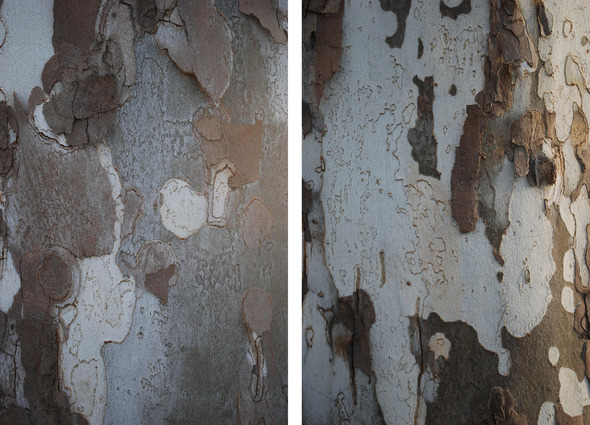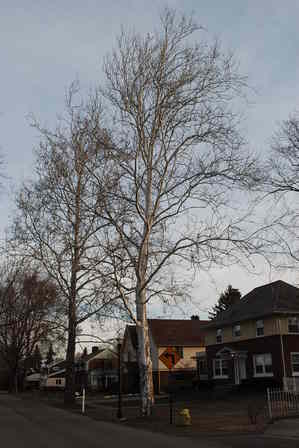Sycamore: This gargantuan native tree needs room to spread

The mottled, peeling bark of American Sycamore (Platanus occidentalis) can be surprisingly artistic, in a modern sort of way.
Rick Meader | Contributor
It's not spring yet, and while the skunk cabbage is probably doing its thing in a swamp near you to hurry things along, we still have time to spend with native woody plants. This tree doesn't exactly have pods, but if you see a stately large tree with splotchy white bark and round balls dangling from its branches, you've seen an American sycamore (Platanus occidentalis), one of a river's most striking plant neighbors.
Sycamore can be a gargantuan tree, growing to heights of almost 120 feet with a wide spread about the same. Its trunk can become massive, too.
In fact, George Washington, in a journal entry, wrote of a sycamore he encountered in 1770 along the Ohio River that measured almost 45 feet around at a point three feet above the ground. Near it was another sycamore that measured 31 feet around.
Early settlers would use these huge trees, which were usually hollow, for storage of meat and other items. Native Americans also used the hollow trees for canoes. (The Big Tree in Michigan south of Berrien Springs measures 120 feet tall, with a spread of 96 inches and a diameter at three feet high of 81 inches).
The trees can live to be 500 years old or more, and become hollow, but still healthy, at about 200 years of age, thus providing a use beyond lumber for those lucky enough to be near a hollow giant. Wildlife also finds the hollows to make good homes.
Sycamores are a member of the family Platanaceae, which is one of the oldest plant families in the world, with relatives dating back 100 million years. American sycamore is native to a range in North America that extends from the southern half of the lower peninsula of Michigan east to Pennsylvania, south to Georgia and west to eastern Texas, Oklahoma, Kansas and most of Iowa. It prefers the rich, moist soils of riverbanks and floodplains but can’t tolerate prolonged inundation during the growing season.
Aside from its size, the most distinguishing characteristic of Sycamore is its bark. Early in life it is an unexciting brown, but as it gets older, the outer bark peels off in large chunks to reveal a mosaic pattern dominated by the white inner bark. It can be quite beautiful in a modern art sort of way, as the introductory photo reveals, and the mostly white upper region of the tree is quite beautiful against a blue winter sky.
Its leaves are also large, spreading to eight to nine inches wide, with three large, pointed lobes that have some smaller points along its edge. In the fall, they turn mostly yellow, but are not particularly showy. The Michigan Flora website has a great photo of it.
Some sycamores may have already lost most of their leaves by then, due to non-fatal anthracnose which often affects the tree. The one-inch wide seed balls are actually clusters of seeds that hang onto the tree through the winter. Eventually they fall and the seedballs break apart into many small seeds.

This sycamore youngster makes a nice street tree, but its trunk could grow almost into the road if allowed to live out its 500 year lifespan.
Rick Meader | Contributor
Its tolerance of some urban conditions makes it an option for street trees. In that situation, though, its cousin, the London Planetree (Platanus xacerifolia), which is a hybrid between the Oriental Plane tree (Platanus orientalis) and the American Sycamore, is used more often. This cross affords it better protection from anthracnose, which can render the Sycamore leafless in early summer.
You can see a difference between the two in two ways. First, the underbark of the Planetree is a little greener than white, especially when compared with a sycamore. Second, the Sycamore has only one seed ball per cluster whereas the hybrid may have one seedball or greater than one seedball per cluster.
For use in the landscape, it is adaptable to many conditions (except sandy dry soils), but you need to give it room to grow and spread its wings. Also, some people don't like the large flakes of bark or large leaves that create a definite change to one's lawn until you clean them up. It is a fast grower, which is actually a nice thing for when you want a large tree fairly quickly. All in all, this is a unique tree, and one that deserves consideration for your yard, if you have the right spot.
It's been a pretty stupid winter, in my opinion, but the longer days and higher sun are getting me in the mood for some landscaping, so in the next entry we'll talk about what you can do with the spots in your yard that tend toward the quagmire.
In the meantime, I'll be getting ready for the Wildflower Association of Michigan conference on March 4-5 in East Lansing. There will be speakers there talking about a range of topics from pollinators, rattlesnakes, butterfly gardens and landscaping with native plants (I'll be one of the speakers talking about that). The public is encouraged to attend. For more information, check out this website: http://www.wildflowersmich.org/index.php?menu=5
Get out and enjoy the encroaching spring everyone — look up for white barked-Sycamores, and down for skunk cabbage!
Rick is a local landscape architect with a special interest in all things natural, including creating designs that include a lot of native plants (and the critters they support). You can contact him at yourland1824@gmail.com.


Comments
Rork Kuick
Tue, Feb 21, 2012 : 1:28 p.m.
Thanks. I had wondered why London Planetree was used, when we have a great native. Rumor from Virginia was that the trunks made good outhouses, and smokehouses. There's interesting variation from year to year in how much white is showing. Stupid winter is right. My ground thawed in there, and daffodil shoots are out. Crossing my fingers for the folks with orchards. My flowers are trivia compared to the state they have.